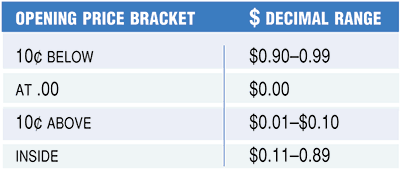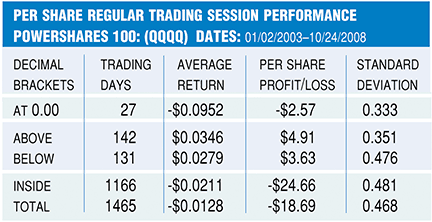TRADING STRATEGIES
How Brackets Make All The Difference
On The Precipice Of
The Nearest Dollar Increment
In a bear market, any piece of information that will give traders a slight edge in performance is always welcome. Here’s how a stock performs when it is trading in the vicinity of the nearest dollar increment.
Success often results from analyzing the smallest pieces of information. On a daily basis, some price patterns may appear unimportant; over a series of trading days, however, they can contribute significantly to your profitability. With the continuing downtrend in worldwide markets, existing trading systems are performing poorly, causing market participants to abandon previous trading strategies. In this current environment, traders are grateful for any new information, especially if it will give them the slightest performance edge. Say a stock begins trading at $40.03 (three cents above the next dollar mark) or $39.97 (three cents below). Does this slightly above/below situation provide us with a trading advantage?
This article analyzes the opening decimal price against differences in the performance of the overnight trading session. It acknowledges the meltdown in equity prices by assessing the performance of this system in the current bearish trading environment. Instead of examining each decimal combination, we collapse the opening price into the four brackets seen in Figure 1.

FIGURE 1: the four opening price brackets
With an average trading volume of 182 million shares in 2007, the PowerShares Qqq are a good representation of investor psychology. The Qs represent the intraday movements of 100 companies, but they trade as a single security, allowing investors to participate in the collective performance of a portfolio of companies. As a result, I am confining this investigation to this most active instrument when it is trading during the regular session. In 1,465 trading days (January 02, 2003—October 24, 2008), they have fallen $18.69 during the regular trading session (Figure 2). You can easily download these historical numbers from finance.yahoo.com into an Excel worksheet.

FIGURE 2: regular trading session performance. The decimal price of an instrument can often be the most compelling reason for entering into a position at the sound of the opening bell. These results demonstrate the performance differences of the regular trading session. In the 1,465 trading days, there was a loss of $18.69 in the regular trading session; however, there are performance differences among these four decimal brackets.